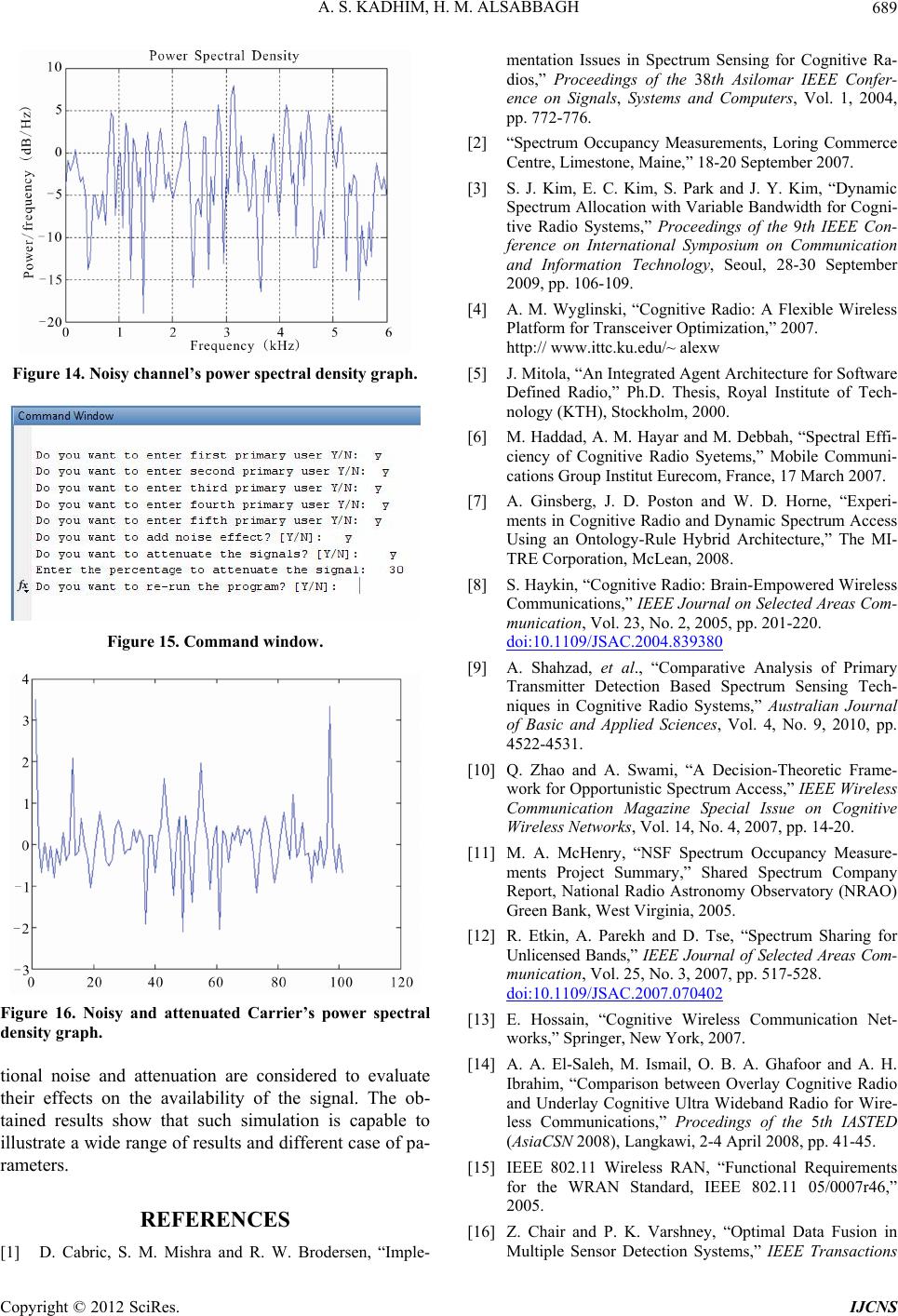
A. S. KADHIM, H. M. ALSABBAGH 689
Figure 14. Noisy channel’s power spe c tral density graph.
Figure 15. Command window.
Figure 16. Noisy and attenuated Carrier’s power spectral
density graph.
tional noise and attenuation are considered to evaluate
their effects on the availability of the signal. The ob-
tained results show that such simulation is capable to
illustrate a wide range of results and different case of pa-
rameters.
REFERENCES
[1] D. Cabric, S. M. Mishra and R. W. Brodersen, “Imple-
mentation Issues in Spectrum Sensing for Cognitive Ra-
dios,” Proceedings of the 38th Asilomar IEEE Confer-
ence on Signals, Systems and Computers, Vol. 1, 2004,
pp. 772-776.
[2] “Spectrum Occupancy Measurements, Loring Commerce
Centre, Limestone, Maine,” 18-20 September 2007.
[3] S. J. Kim, E. C. Kim, S. Park and J. Y. Kim, “Dynamic
Spectrum Allocation with Variable Bandwidth for Cogni-
tive Radio Systems,” Proceedings of the 9th IEEE Con-
ference on International Symposium on Communication
and Information Technology, Seoul, 28-30 September
2009, pp. 106-109.
[4] A. M. Wyglinski, “Cognitive Radio: A Flexible Wireless
Platform for Transceiver Optimization,” 2007.
http:// www.ittc.ku.edu/~ alexw
[5] J. Mitola, “An Integrated Agent Architecture for Software
Defined Radio,” Ph.D. Thesis, Royal Institute of Tech-
nology (KTH), Stockholm, 2000.
[6] M. Haddad, A. M. Hayar and M. Debbah, “Spectral Effi-
ciency of Cognitive Radio Syetems,” Mobile Communi-
cations Group Institut Eurecom, France, 17 March 2007.
[7] A. Ginsberg, J. D. Poston and W. D. Horne, “Experi-
ments in Cognitive Radio and Dynamic Spectrum Access
Using an Ontology-Rule Hybrid Architecture,” The MI-
TRE Corporation, McLean, 2008.
[8] S. Haykin, “Cognitive Radio: Brain-Empowered Wireless
Communications,” IEEE Journal on Selected Areas Com-
munication, Vol. 23, No. 2, 2005, pp. 201-220.
doi:10.1109/JSAC.2004.839380
[9] A. Shahzad, et al., “Comparative Analysis of Primary
Transmitter Detection Based Spectrum Sensing Tech-
niques in Cognitive Radio Systems,” Australian Journal
of Basic and Applied Sciences, Vol. 4, No. 9, 2010, pp.
4522-4531.
[10] Q. Zhao and A. Swami, “A Decision-Theoretic Frame-
work for Opportunistic Spectrum Access,” IEEE Wireless
Communication Magazine Special Issue on Cognitive
Wireless Networks, Vol. 14, No. 4, 2007, pp. 14-20.
[11] M. A. McHenry, “NSF Spectrum Occupancy Measure-
ments Project Summary,” Shared Spectrum Company
Report, National Radio Astronomy Observatory (NRAO)
Green Bank, West Virginia, 2005.
[12] R. Etkin, A. Parekh and D. Tse, “Spectrum Sharing for
Unlicensed Bands,” IEEE Journal of Selected Areas Com-
munication, Vol. 25, No. 3, 2007, pp. 517-528.
doi:10.1109/JSAC.2007.070402
[13] E. Hossain, “Cognitive Wireless Communication Net-
works,” Springer, New York, 2007.
[14] A. A. El-Saleh, M. Ismail, O. B. A. Ghafoor and A. H.
Ibrahim, “Comparison between Overlay Cognitive Radio
and Underlay Cognitive Ultra Wideband Radio for Wire-
less Communications,” Procedings of the 5th IASTED
(AsiaCSN 2008), Langkawi, 2-4 April 2008, pp. 41-45.
[15] IEEE 802.11 Wireless RAN, “Functional Requirements
for the WRAN Standard, IEEE 802.11 05/0007r46,”
2005.
[16] Z. Chair and P. K. Varshney, “Optimal Data Fusion in
Multiple Sensor Detection Systems,” IEEE Transactions
Copyright © 2012 SciRes. IJCNS